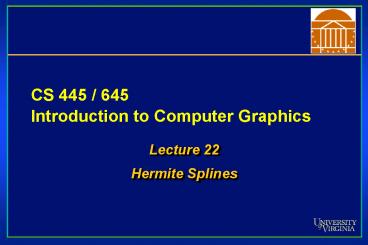CS 445 645 Introduction to Computer Graphics - PowerPoint PPT Presentation
1 / 32
Title:
CS 445 645 Introduction to Computer Graphics
Description:
I'm showing movies that you can watch after class today (or some other day) Splines Old School ... Problems with series of points used to model a curve ... – PowerPoint PPT presentation
Number of Views:112
Avg rating:3.0/5.0
Title: CS 445 645 Introduction to Computer Graphics
1
CS 445 / 645Introduction to Computer Graphics
- Lecture 22
- Hermite Splines
2
ACM Elections
- Should take 15 minutes
- Taking place now in OLS 120
- Hurry Back
- Im showing movies that you can watch after class
today (or some other day)
3
Splines Old School
4
Representations of Curves
- Problems with series of points used to model a
curve - Piecewise linear - Does not accurately model a
smooth line - Its tedious
- Expensive to manipulate curve because all points
must be repositioned - Instead, model curve as piecewise-polynomial
- x x(t), y y(t), z z(t)
- where x(), y(), z() are polynomials
5
Specifying Curves (hyperlink)
- Control Points
- A set of points that influence the curves shape
- Knots
- Control points that lie on the curve
- Interpolating Splines
- Curves that pass through the control points
(knots) - Approximating Splines
- Control points merely influence shape
6
Parametric Curves
- Very flexible representation
- They are not required to be functions
- They can be multivalued with respect to any
dimension
7
Cubic Polynomials
- x(t) axt3 bxt2 cxt dx
- Similarly for y(t) and z(t)
- Let t (0 lt t lt 1)
- Let T t3 t2 t 1
- Coefficient Matrix C
- Curve Q(t) TC
8
Parametric Curves
- How do we find the tangent to a curve?
- If f(x) x2 4
- tangent at (x3) is f(x) 2 (x) 4 2 (3) - 4
- Derivative of Q(t) is the tangent vector at t
- d/dt Q(t) Q(t) d/dt T C 3t2 2t 1 0 C
9
Piecewise Curve Segments
- One curve constructed by connecting many smaller
segments end-to-end - Continuity describes the joint
- C1 is tangent continuity (velocity)
- C2 is 2nd derivative continuity (acceleration)
10
Continuity of Curves
- If direction (but not necessarily magnitude) of
tangent matches - G1 geometric continuity
- The tangent value at the end of one curve is
proportional to the tangent value of the
beginning of the next curve - Matching direction and magnitude of dn / dtn
- Cn continous
11
Parametric Cubic Curves
- In order to assure C2 continuity, curves must be
of at least degree 3 - Here is the parametric definition of a cubic
(degree 3) spline in two dimensions - How do we extend it to three dimensions?
12
Parametric Cubic Splines
- Can represent this as a matrix too
13
Coefficients
- So how do we select the coefficients?
- ax bx cx dx and ay by cy dy must satisfy the
constraints defined by the knots and the
continuity conditions
14
Parametric Curves
- Difficult to conceptualize curve as x(t) axt3
bxt2 cxt dx(artists dont think in terms
of coefficients of cubics) - Instead, define curve as weighted combination of
4 well-defined cubic polynomials(wait a second!
Artists dont think this way either!) - Each curve type defines different cubic
polynomials and weighting schemes
15
Parametric Curves
- Hermite two endpoints and two endpoint tangent
vectors - Bezier - two endpoints and two other points that
define the endpoint tangent vectors - Splines four control points
- C1 and C2 continuity at the join points
- Come close to their control points, but not
guaranteed to touch them - Examples of Splines
16
Hermite Cubic Splines
- An example of knot and continuity constraints
17
Hermite Cubic Splines
- One cubic curve for each dimension
- A curve constrained to x/y-plane has two curves
18
Hermite Cubic Splines
- A 2-D Hermite Cubic Spline is defined by eight
parameters a, b, c, d, e, f, g, h - How do we convert the intuitive endpoint
constraints into these (relatively) unintuitive
eight parameters? - We know
- (x, y) position at t 0, p1
- (x, y) position at t 1, p2
- (x, y) derivative at t 0, dp/dt
- (x, y) derivative at t 1, dp/dt
19
Hermite Cubic Spline
- We know
- (x, y) position at t 0, p1
20
Hermite Cubic Spline
- We know
- (x, y) position at t 1, p2
21
Hermite Cubic Splines
- So far we have four equations, but we have eight
unknowns - Use the derivatives
22
Hermite Cubic Spline
- We know
- (x, y) derivative at t 0, dp/dt
23
Hermite Cubic Spline
- We know
- (x, y) derivative at t 1, dp/dt
24
Hermite Specification
- Matrix equation for Hermite Curve
t3 t2 t1 t0
t 0
p1
t 1
p2
t 0
r p1
r p2
t 1
25
Solve Hermite Matrix
26
Spline and Geometry Matrices
MHermite
GHermite
27
Resulting Hermite Spline Equation
28
Demonstration
- Hermite
29
Sample Hermite Curves
30
Blending Functions
- By multiplying first two matrices in lower-left
equation, you have four functions of t that
blend the four control parameters - These are blendingfunctions
31
Hermite Blending Functions
- If you plot the blending functions on the
parameter t
32
Hermite Blending Functions
- Remember, eachblending functionreflects
influenceof P1, P2, DP1, DP2on splines shape






























